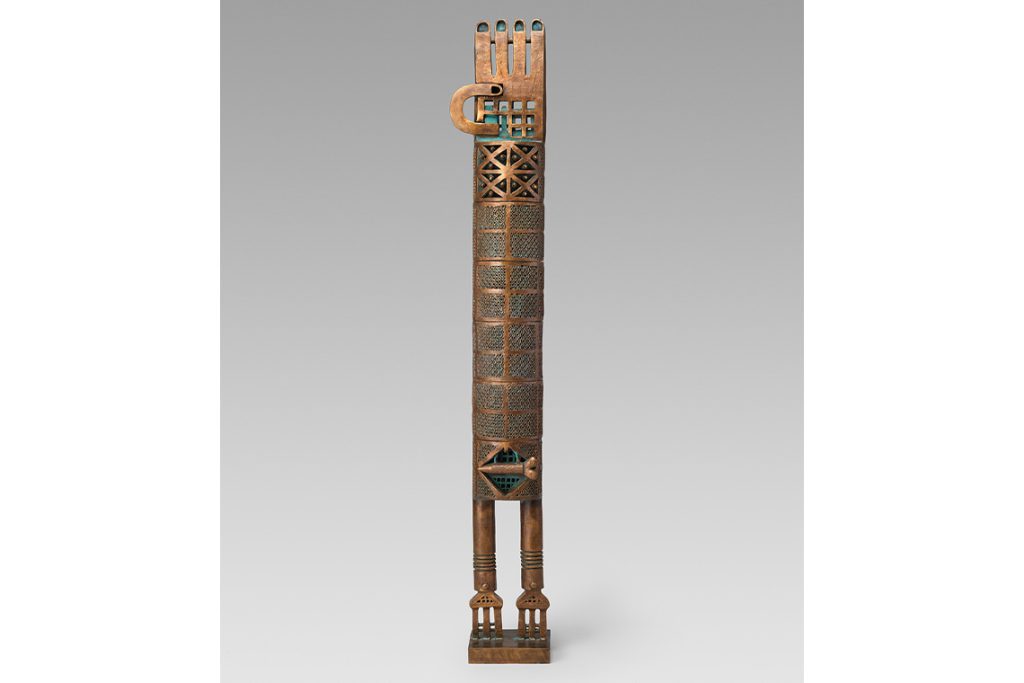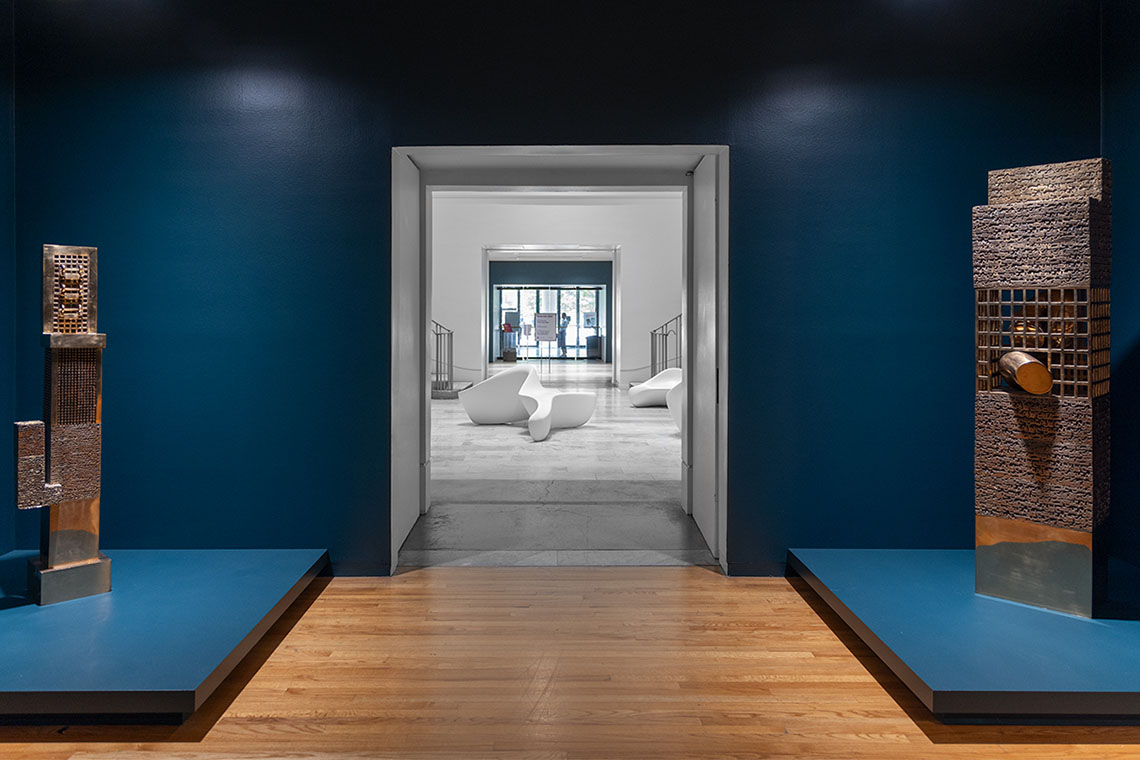Poets, Locks, Cages at Vancouver Art Gallery marks the first major institutional show of Iran’s pioneering modernist Parviz Tanavoli in Canada, his second home for more than 30 years.
It’s no small irony that master sculptor Parviz Tanavoli’s long-awaited survey show in his adopted hometown of Vancouver, where he has lived since 1989, only materialised as he lost his voice due to Parkinson’s disease. Sadly unavailable for interview, Panavoli was said to have been pleased to see so many of his “children” exhibited together – spanning six decades and including many rarely shown pieces from private collections and museums. Happily, the voices of his artistic offspring speak for themselves at the Vancouver Art Gallery’s exhibition Poets, Locks, Cages.
As organised by curator Pantea Haghighi, the exhibition lacks a strong sense of linear narrative; rather – and fittingly for an exhibition featuring Tanavoli’s paintings on old manuscripts culled from Tehrani markets – this is survey show as bazaar. While each of the exhibition’s sections are individually themed, it is the sense of dialogue between them that animates the show. The pieces range from miniature to monumental and are gathered as old friends reunited in honour of their maker.
Amidst the conversational tone of the exhibition, there is also a sense of gravitas, as this may well be the great artist’s last show of his lifetime. It follows a small 2019 exhibition at the West Vancouver Art Museum entitled Oh Nightingale, and his 2017 solo exhibition at the Tehran Museum of Contemporary Art (TMoCA), Parviz Tanavoli and the Lions of Iran. The TMoCA exhibition, which showed the cultural continuum of the lion as a symbol from ancient, Islamic and modern periods, featured large-scale works by Tanavoli and artefacts from his personal collection alongside loans from the National Museum of Ancient Iran. “The intent with this exhibition,” he told me at the time,“is to present a symbol – the lion, which has persevered for 5000 years. This is my way of demonstrating that Iranian culture has survived for millennia and will not disappear. Politics cannot destroy it.”

Similarly, Poets, Locks, Cages is a testament not only to Tanavoli’s great artistry but also to his perseverance. The lion of Iranian art and his work embodied, united and ultimately transcended, many dichotomies. In addition to pre- and post-Islamic art, the middle-class Tehrani who was patronised by Empress Farah and went on to become one of the highest-earning living Iranian artists, successfully straddled pre- and post-Revolutionary cultures, as well as the sacred and the secular and the West and the Middle East. The man who modernised Iranian sculpture was a contemporary Farhad the Mountain Carver – the legendary figure who carved through mountains to win the affection of his love, Shirin. As quoted in the handsome catalogue accompanying the exhibition, Tanavoli said, “Before him, there was no sculpture, and frankly he was the only figure I could study. As a result, he became the central protagonist for many years and many of my sculptures.”
In the same catalogue Haghighi states that her intent is to show the way in which Tanavoli layered sacred and secular histories in his work: “This integration of the forms and philosophies of international modernism with the crafts and symbols of Iran’s rich popular culture is a crucial aspect of both Tanavoli’s particular practice and the development of modern sculpture in Iran at large.”
The exhibition takes viewers through the artist’s early days studying sculpture in Milan and as a pioneer of the Saqqakhaneh movement that married traditional Persian idioms with contemporary art and onto a section featuring rarely seen early works from the Grey Art Gallery. Subsequent sections blend eras and media in a visual feast.
The artist is championed throughout as a visual poet, entranced by traditional locks and grillwork or “cages”. As a boy, Tanavoli was fascinated by the travelling locksmiths of Tehran. “They could fashion keys for any lock. It was like magic,” he told me in 2015. He became an avid amateur locksmith, fashioning keys for friends and families, and also explained to me how, as the son of a restaurateur who catered to religious Shia pilgrims, he was also captivated by their devotional rituals and objects.

The three titular themes travel successfully throughout the exhibition. Tanavoli’s signature Heech (Farsi for ‘nothing’) series (1965–ongoing), which began as a protest against the emptiness of the Iranian art world in 1965 and morphed into a political protest about Guantanamo in 2005, evoking both a Sartrean and Sufi ‘being and nothingness’ aesthetic, is well represented here. (As Rumi wrote, we came whirling out of nothingness scattering stars like dust). It’s not surprising that Tanavoli’s elegant sculptural poems also became earrings and necklaces, their strength and delicacy representing the jewels – and paradoxes – of human existence.
Amidst the stunning sculptures from the artist’s personal collection and private donors, such as 1973’s Standing Poet with Heech II, there are some wonderful surprises. The aforementioned paintings on antique manuscripts, fuse the sacred with the irreverent, while the magnificent duo of paintings from 1962 and 1964 – both named The Last Poet of Iran – demonstrate the artist’s unique cuneiform-like visual language, which would eventually merge into decorative but “meaningless” script embedded into sculptures.
While Tanavoli’s secret language may have mystified the conservative art world of mid-century Iran, it is certainly appreciated by a whole new generation. The opening day of the exhibition was full of rapt PhD students in art history, many of whom had flown across continents to see his work in the flesh. “Shrines in Iran are beautiful,” Tanavoli told me in 2015. “They are like museums made by masters.” In the temporary shrine to his work that this exhibition has become, one wonders if it is perhaps the moment for a museum in his adopted homeland, to twin with the one at his house in Tehran. It would be a timely tribute to the man who has carved poetry out of nothingness, transformed cages into beauty and unlocked the Persian spirit, channelling it through a contemporary idiom and giving it new life.
Poets, Locks, Cages runs until 19 November 2023



